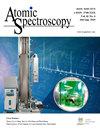Advances In The Multi-Elemental Analysis Of Solder By ETV-ICPOES For The Discrimination Of Forensic Evidence
IF 2.3
2区 化学
Q1 SPECTROSCOPY
引用次数: 0
Abstract
: Lead-tin solder is a useful piece of evidence from a crime scene and may be examined for information related to the construction or source of an improvised explosive device (IED). A technique based on electrothermal vaporization into inductively coupled plasma optical emission spectrometry was improved for the direct quantification of trace and major elements in solder (Ag, As, Bi, Cr, Fe, Sb, Sn). NIST 1728, a tin-alloy certified reference material, was used for external calibration and achieve a direct, fully solid-sampling procedure using only 0.5–3.0 mg of sample. Point-by-point internal standardization with Ar 404.442 nm was performed to compensate for sample loading effects on the plasma, and a background correction technique was introduced to improve the overall efficiency of analysis. As solder was observed to change composition during some mock scenarios of IED preparation, which limits how solder can be examined in forensics, different soldering conditions (temperature, solder size, cleaning of the soldering tip or not between subsequent samples) were studied using an Fe-tip soldering device. Statistical analyses including Student’s t-tests and a one-way analysis of variance revealed that none of these conditions resulted in contamination of the melted solder sample, hence confirming the viability of the mock procedure used to replicate IED soldering in research. A new qualitative discrimination method is introduced and demonstrated in a blind trial for matching and discriminating lead-tin solders. This method represents an improvement from past research and has potential for use in evaluating other forensic evidence involving ferrous-alloysETV-ICPOES法鉴定锡料多元素分析进展
:铅锡焊料是犯罪现场的有用证据,可以检查是否有与简易爆炸装置的构造或来源有关的信息。改进了一种基于电热蒸发-电感耦合等离子体发射光谱法直接测定焊料中微量元素和主要元素(Ag、As、Bi、Cr、Fe、Sb、Sn)的技术。NIST 1728是一种锡合金认证的参考材料,用于外部校准,并仅使用0.5–3.0 mg样品实现了直接、完全固体采样程序。用Ar 404.442nm进行逐点内部标准化,以补偿样品加载对等离子体的影响,并引入背景校正技术来提高分析的整体效率。由于在IED制备的一些模拟场景中观察到焊料会改变成分,这限制了在取证中检查焊料的方式,因此使用Fe尖端焊接设备研究了不同的焊接条件(温度、焊料尺寸、焊接尖端的清洁或后续样品之间的清洁)。包括Student t检验和单向方差分析在内的统计分析表明,这些条件都没有导致熔化的焊料样品受到污染,因此证实了在研究中用于复制IED焊接的模拟程序的可行性。介绍了一种新的定性鉴别方法,并在铅锡焊料匹配鉴别的盲试中进行了验证。这种方法是对过去研究的改进,有可能用于评估其他涉及铁合金的法医证据
本文章由计算机程序翻译,如有差异,请以英文原文为准。
求助全文
约1分钟内获得全文
求助全文
来源期刊

Atomic Spectroscopy
物理-光谱学
CiteScore
5.30
自引率
14.70%
发文量
42
审稿时长
4.5 months
期刊介绍:
The ATOMIC SPECTROSCOPY is a peer-reviewed international journal started in 1962 by Dr. Walter Slavin and now is published by Atomic Spectroscopy Press Limited (ASPL). It is intended for the rapid publication of both original articles and review articles in the fields of AAS, AFS, ICP-OES, ICP-MS, GD-MS, TIMS, SIMS, AMS, LIBS, XRF and related techniques. Manuscripts dealing with (i) instrumentation & fundamentals, (ii) methodology development & applications, and (iii) standard reference materials (SRMs) development can be submitted for publication.
 求助内容:
求助内容: 应助结果提醒方式:
应助结果提醒方式:


